handbrake Lancia Ypsilon 2003 Owner handbook (in English)
[x] Cancel search | Manufacturer: LANCIA, Model Year: 2003, Model line: Ypsilon, Model: Lancia Ypsilon 2003Pages: 191, PDF Size: 2.45 MB
Page 19 of 191
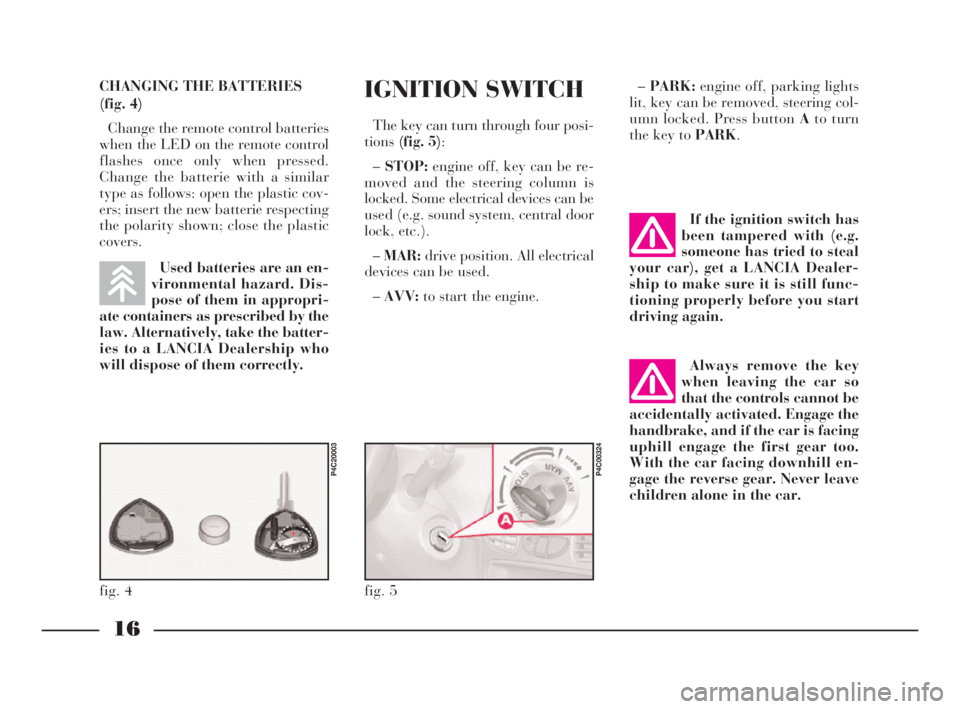
IGNITION SWITCH
The key can turn through four posi-
tions(fig. 5):
–STOP:engine off, key can be re-
moved and the steering column is
locked. Some electrical devices can be
used (e.g. sound system, central door
lock, etc.).
–MAR:drive position. All electrical
devices can be used.
–AVV:to start the engine.–PARK:engine off, parking lights
lit, key can be removed, steering col-
umn locked. Press button Ato turn
the key to PARK.
fig. 5
P4C00324
If the ignition switch has
been tampered with (e.g.
someone has tried to steal
your car), get a LANCIA Dealer-
ship to make sure it is still func-
tioning properly before you start
driving again.
Always remove the key
when leaving the car so
that the controls cannot be
accidentally activated. Engage the
handbrake, and if the car is facing
uphill engage the first gear too.
With the car facing downhill en-
gage the reverse gear. Never leave
children alone in the car.
16
G
CHANGING THE BATTERIES
(fig. 4)
Change the remote control batteries
when the LED on the remote control
flashes once only when pressed.
Change the batterie with a similar
type as follows: open the plastic cov-
ers; insert the new batterie respecting
the polarity shown; close the plastic
covers.
Used batteries are an en-
vironmental hazard. Dis-
pose of them in appropri-
ate containers as prescribed by the
law. Alternatively, take the batter-
ies to a LANCIA Dealership who
will dispose of them correctly.
fig. 4
P4C20003
4C001-067 ING 11-03-2008 11:57 Pagina 16
Page 37 of 191
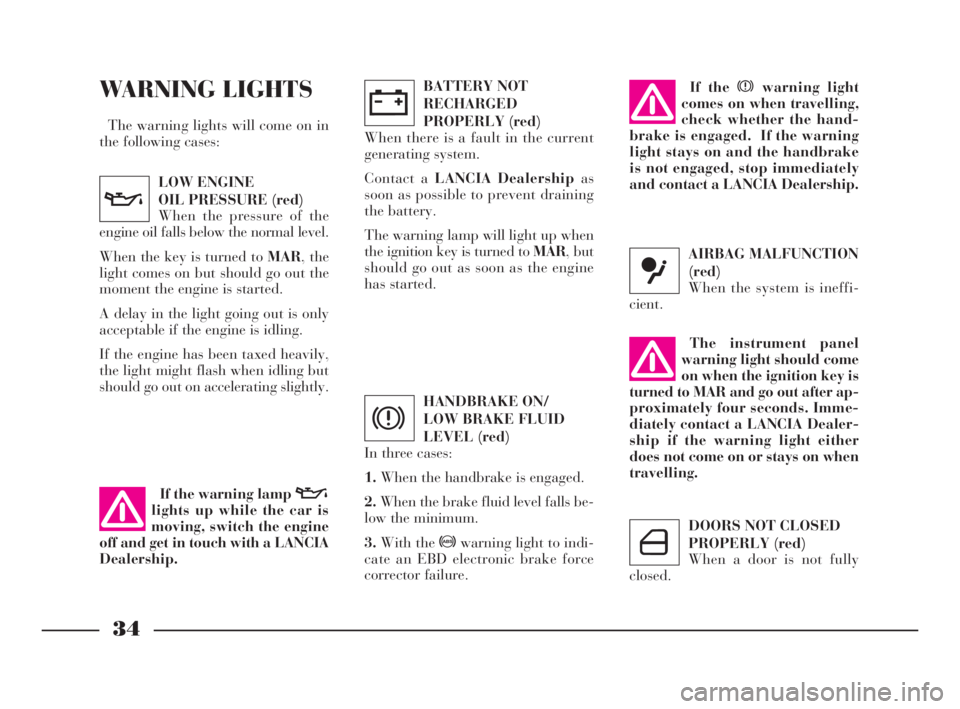
34
G
WARNING LIGHTS
The warning lights will come on in
the following cases:
LOW ENGINE
OIL PRESSURE (red)
When the pressure of the
engine oil falls below the normal level.
When the key is turned to MAR, the
light comes on but should go out the
moment the engine is started.
A delay in the light going out is only
acceptable if the engine is idling.
If the engine has been taxed heavily,
the light might flash when idling but
should go out on accelerating slightly.
v
BATTERY NOT
RECHARGED
PROPERLY (red)
When there is a fault in the current
generating system.
Contact a LANCIA Dealership as
soon as possible to prevent draining
the battery.
The warning lamp will light up when
the ignition key is turned to MAR, but
should go out as soon as the engine
has started.
w
If the warning lamp v
lights up while the car is
moving, switch the engine
off and get in touch with a LANCIA
Dealership.
HANDBRAKE ON/
LOW BRAKE FLUID
LEVEL (red)
In three cases:
1.When the handbrake is engaged.
2.When the brake fluid level falls be-
low the minimum.
3.With the >warning light to indi-
cate an EBD electronic brake force
corrector failure.
x
If the xwarning light
comes on when travelling,
check whether the hand-
brake is engaged. If the warning
light stays on and the handbrake
is not engaged, stop immediately
and contact a LANCIA Dealership.
AIRBAG MALFUNCTION
(red)
When the system is ineffi-
cient.
û
The instrument panel
warning light should come
on when the ignition key is
turned to MAR and go out after ap-
proximately four seconds. Imme-
diately contact a LANCIA Dealer-
ship if the warning light either
does not come on or stays on when
travelling.
DOORS NOT CLOSED
PROPERLY (red)
When a door is not fully
closed.
´
4C001-067 ING 11-03-2008 11:57 Pagina 34
Page 59 of 191

56
G
ABS
The car is fitted with an ABS brak-
ing system that prevents the wheels
locking when braking, it exploits the
grip on the road surface holding the
car in the case of sudden braking.
The driver becomes aware of the
ABS activation through a slight throb-
bing of the brake pedal and the rele-
vant noise it makes.
This does not indicate brake mal-
functioning, it is an indication to the
driver that the ABS is operating. It is
a warning that the car is travelling at
borderline road grip and therefore the
speed should be adjusted to the type
of road surface.
The ABS is an addition to the basic
braking system; in the case of a fail-
ure it disables, leaving the braking
system in the same conditions as a ve-
hicle without ABS installed. COMPENSATION
FOR THE UPWARD SLANT
OF THE HEADLIGHT BEAMS
When the car is loaded, it “slopes”
backwards. This means that the head-
light beam rises. In this case it is nec-
essary to return it to the correct posi-
tion.
The car is fitted with an electric ad-
juster(fig. 84)situated at the side of
the handbrake:
Position0- one or two people on the
front seats.
Position1- five people.
Position2- five people + load in
luggage compartment.
Position3- driver + maximum per-
missible load all in the boot.
fig. 84
P4C00105
Check the positioning of
the headlight beams every
time you change the load
to be carried.
IMPORTANTIn order that the ad-
juster operates properly, the load in
the boot must not exceed the maxi-
mum values indicated.
ADJUSTING THE BEAM
OF THE FRONT FOGLIGHTS
Ask a LANCIA Dealershipto check
and, if necessary, adjust the beam for
you.
4C001-067 ING 11-03-2008 11:57 Pagina 56
Page 72 of 191

69
G
STARTING
THE ENGINEIf the engine does not start at the
first attempt, return the ignition key
toSTOPbefore trying to start the en-
gine again.
If warning light ¢remains lit to-
gether with the warning light
when the ignition key is at MAR,
turn the key to STOPand then to
MAR; if the warning light still re-
mains lit, try with the other keys pro-
vided with the car.
If you are still unable to start the en-
gine, follow the emergency startup
procedure (see “Emergency startup”
in the section “In an emergency”) and
go to the nearest LANCIA Dealer-
shipimmediately.
IMPORTANTDo not leave the ig-
nition key at MARwhen the engine is
off.
The ignition switch fits a safety de-
vice. If the engine does not start at the
first attempt, return the ignition key
toSTOPbefore trying to start the en-
gine again.
In a similar way, you will not be able
to turn the key from MARtoAVV
when the engine is running.It is dangerous to let the
engine run in a garage or
other closed area. The en-
gine consumes oxygen and gives
off carbon dioxide, carbon monox-
ide and other poisonous fumes.
Do not touch the high
voltage cables (spark plug
cables) when the engine is
running.
During the running-in
period do not push the car
up to its highest perfor-
mance (e.g. sudden accelerations,
very long drives at high speed,
sharp braking etc.)
PROCEDURE
IMPORTANTDo not press on the
accelerator before the engine is run-
ning.
1)Make sure the handbrake is up.
2)Put the gear lever into neutral.
3)Press the clutch pedal down to the
floor.
4)Turn the ignition key to AVVand
let it go the moment the engine starts.
4C068-089 ING 11-03-2008 11:59 Pagina 69
Page 74 of 191
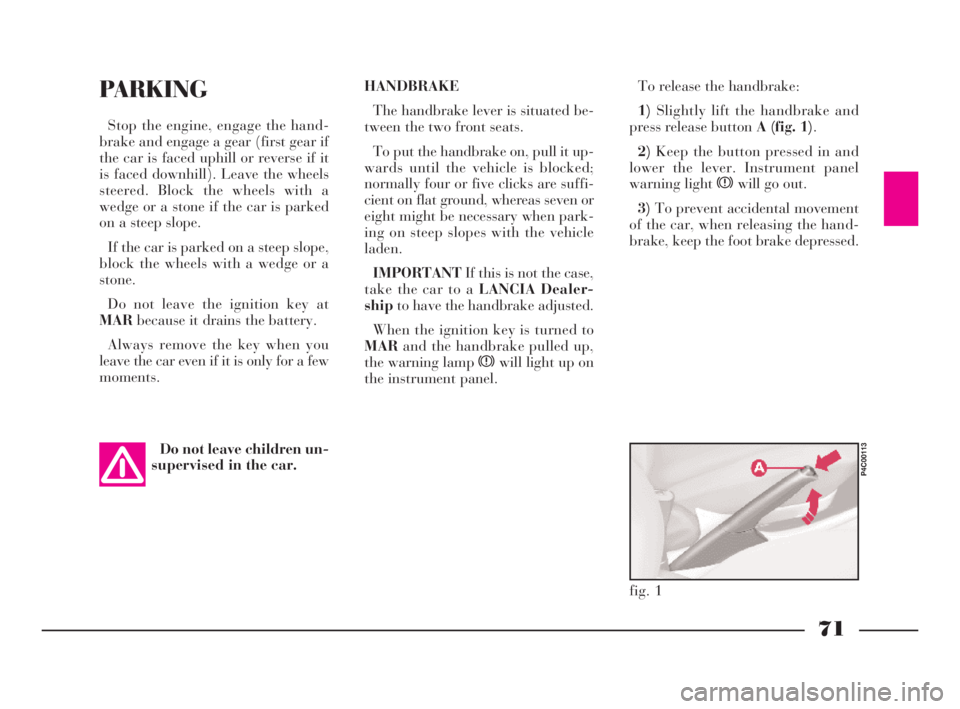
71
G
HANDBRAKE
The handbrake lever is situated be-
tween the two front seats.
To put the handbrake on, pull it up-
wards until the vehicle is blocked;
normally four or five clicks are suffi-
cient on flat ground, whereas seven or
eight might be necessary when park-
ing on steep slopes with the vehicle
laden.
IMPORTANTIf this is not the case,
take the car to a LANCIA Dealer-
shipto have the handbrake adjusted.
When the ignition key is turned to
MARand the handbrake pulled up,
the warning lamp xwill light up on
the instrument panel.To release the handbrake:
1)Slightly lift the handbrake and
press release button A (fig. 1).
2)Keep the button pressed in and
lower the lever. Instrument panel
warning light xwill go out.
3)To prevent accidental movement
of the car, when releasing the hand-
brake, keep the foot brake depressed.PARKING
Stop the engine, engage the hand-
brake and engage a gear (first gear if
the car is faced uphill or reverse if it
is faced downhill). Leave the wheels
steered. Block the wheels with a
wedge or a stone if the car is parked
on a steep slope.
If the car is parked on a steep slope,
block the wheels with a wedge or a
stone.
Do not leave the ignition key at
MARbecause it drains the battery.
Always remove the key when you
leave the car even if it is only for a few
moments.
Do not leave children un-
supervised in the car.
fig. 1
P4C00113
4C068-089 ING 11-03-2008 11:59 Pagina 71
Page 90 of 191

87
G
The maximum speed of
snow tyres with a “Q” in-
dication must never ex-
ceed 160 km/h and in any case
must always observe the regula-
tions of the Highway Code.Therefore they should only be used
for the purpose for which they have
been homologated (“Q” indicates that
the tyre is designed for a speed of less
than 160 km/h).
IMPORTANTWhen using snow
tyres with a maximum speed index
that is less than the capacity of the car
(increased by 5%), place in the pas-
senger compartment, well in sight, a
warning that indicates the maximum
speed permitted by the snow tyres (in
accordance with the EC Directive).
Fit four identical tyres (same make
and tread) on the wheels to ensure
safety when driving and when brak-
ing as well as easy handling.
Do not reverse the direction of rota-
tion of the tyres.STORING THE CAR
Do the following if the car is not to
be used for more than a month:
– Park the car in covered, dry and if
possible well-ventilated premises.
– Engage a gear.
– Remove the cables from the bat-
tery terminals (first remove the cable
to the negative terminal) and check
the battery charge. This check should
be carried out once every three
months while the car is in storage.
Recharge the battery if the no-load
voltage is less than 12.5V.
– Make sure the handbrake is not
engaged.
– Clean and protect the painted
parts using protective wax.
4C068-089 ING 11-03-2008 11:59 Pagina 87
Page 100 of 191

97
G
1. STOP THE CAR
– Stop the car so it is not a danger
for on-coming traffic and in such a
position that the tyre can be changed
in safety. The ground must be flat and
adequately firm. During the night,
chose a lit area, if possible.
– Turn engine off and engage the
handbrake.
– Engage first or reverse gear.
– Signal that the car is stopped ac-
cording to traffic regulations: hazard
lights, warning triangle, etc.
Any passengers must leave the car
and watch out for traffic while the
tyre is being changed.
If the ground is sloping or bumpy,
place wedges or other suitable mate-
rial for stopping the car under the
wheels.2. TAKE OUT THE TOOLS,
JACK AND SPARE WHEEL
(space-saver wheel)
They are in the boot.
– Lift the carpeting.
– Unscrew the fastener A (fig. 2)
and take out the tool holder.
The tool holder contains:
B- vehicle tow ring;
C- jack handle;
D- wheel bolt wrench;
E- screwdriver;F- extension for screwing wheel
bolts and inflation valve cap;
G- jack.
fig. 4
P4C00402
fig. 5
P4C00045
4C090-119 ING 11-03-2008 12:00 Pagina 97
Page 125 of 191
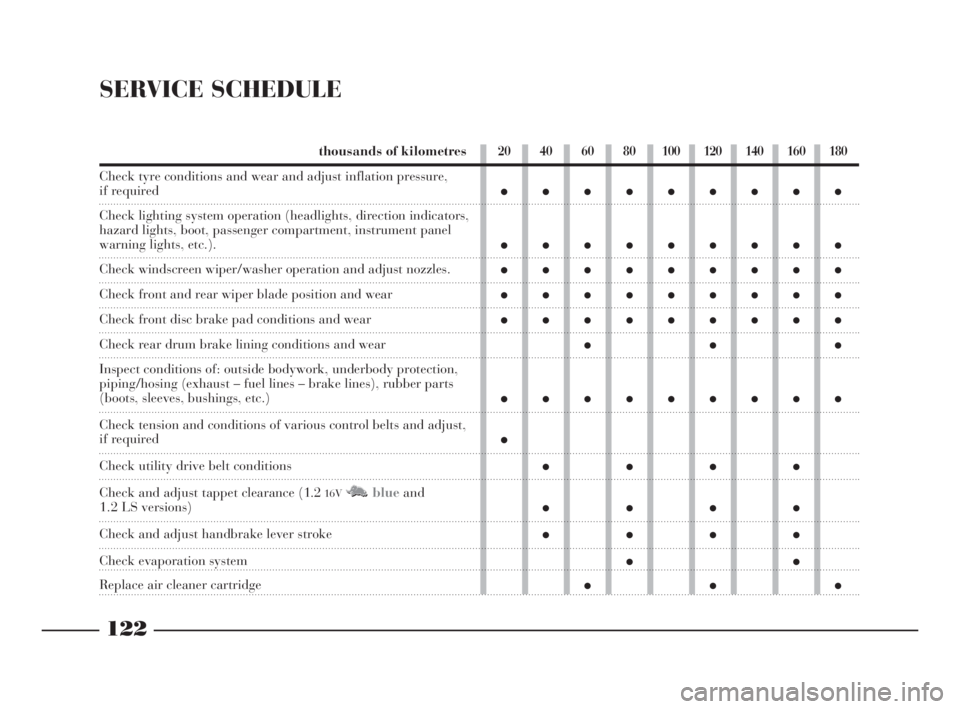
122
G
SERVICE SCHEDULE
thousands of kilometres
Check tyre conditions and wear and adjust inflation pressure,
if required
Check lighting system operation (headlights, direction indicators,
hazard lights, boot, passenger compartment, instrument panel
warning lights, etc.).
Check windscreen wiper/washer operation and adjust nozzles.
Check front and rear wiper blade position and wear
Check front disc brake pad conditions and wear
Check rear drum brake lining conditions and wear
Inspect conditions of: outside bodywork, underbody protection,
piping/hosing (exhaust – fuel lines – brake lines), rubber parts
(boots, sleeves, bushings, etc.)
Check tension and conditions of various control belts and adjust,
if required
Check utility drive belt conditions
Check and adjust tappet clearance (1.2
16VM Nblueand1.2 LS versions)
Check and adjust handbrake lever stroke
Check evaporation system
Replace air cleaner cartridge
20 40 60 80 100 120 140 160 180
●●●●●●●●●
●●●●●●●●●
●●●●●●●●●
●●●●●●●●●
●●●●●●●●●
●●●
●●●●●●●●●
●
●●●●
●●●●
●●●●
●●
●●●
4C120-143 ING 11-03-2008 12:01 Pagina 122
Page 154 of 191

151
G
Drive transmission to the front
wheels by means of half-shafts con-
nected to the differential assembly
and the wheels with CV joints.
The ratios are:Final drive gear and differential as-
sembly incorporated in the gearbox.
Version Final drive ratio Number of teeth
1.2 3.438 16/55
1.216V3.438 16/55
1.216VM Nrosso3.867 15/58
BRAKES
SERVICE AND EMERGENCY
BRAKES
Cross-over hydraulic circuit control.
8" vacuum brake booster.
Front: disc, floating caliper type with
operating cylinder for each wheel.
Rear: drum type with self-centring
shoes with operating cylinder for each
wheel.
Automatic take up of clearance due
to friction lining wear.
Brake effort apportioning valve
working on the hydraulic circuit of
the rear brakes (for versions without
ABS).
Four channel, four sensor ABS (op-
tional for 1.2 versions, standard for LX
and 1.2
16Vversions) with electronic
brake force distributor.
HANDBRAKE
Controlled by a lever, it works me-
chanically on the rear brake shoes.
4C144-167 ING 11-03-2008 12:02 Pagina 151
Page 181 of 191
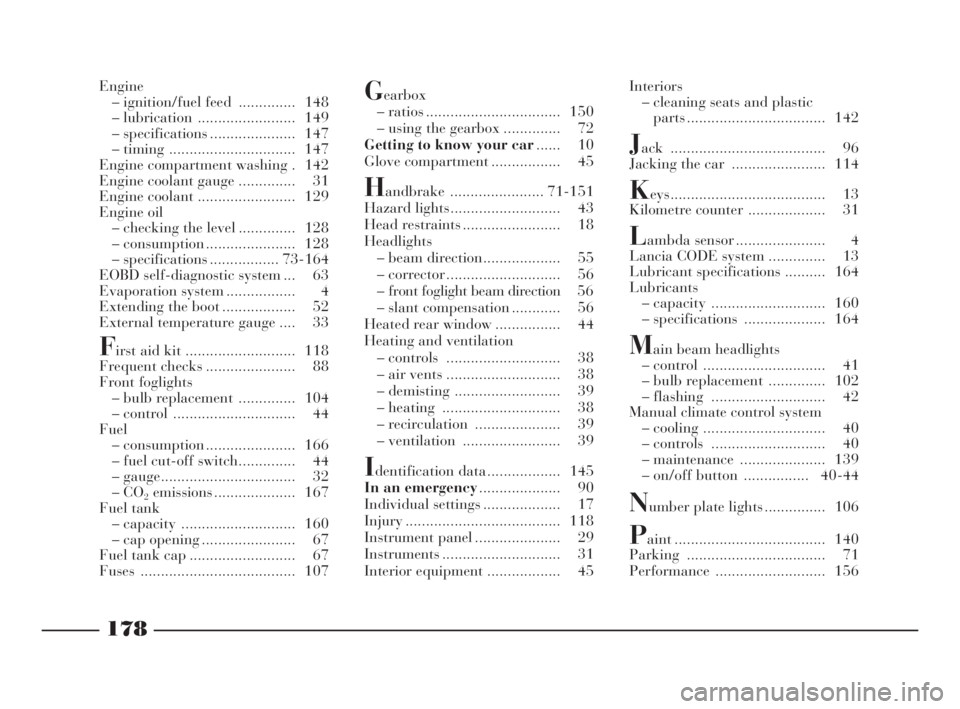
178
fdG
Interiors
– cleaning seats and plastic
parts .................................. 142
Jack ...................................... 96
Jacking the car ....................... 114
Keys...................................... 13
Kilometre counter ................... 31
Lambda sensor ...................... 4
Lancia CODE system .............. 13
Lubricant specifications .......... 164
Lubricants
– capacity ............................ 160
– specifications .................... 164
Main beam headlights
– control .............................. 41
– bulb replacement .............. 102
– flashing ............................ 42
Manual climate control system
– cooling .............................. 40
– controls ............................ 40
– maintenance ..................... 139
– on/off button ................ 40-44
Number plate lights ............... 106
Paint ..................................... 140
Parking .................................. 71
Performance ........................... 156 Engine
– ignition/fuel feed .............. 148
– lubrication ........................ 149
– specifications ..................... 147
– timing ............................... 147
Engine compartment washing . 142
Engine coolant gauge .............. 31
Engine coolant ........................ 129
Engine oil
– checking the level .............. 128
– consumption ...................... 128
– specifications ................. 73-164
EOBD self-diagnostic system ... 63
Evaporation system ................. 4
Extending the boot .................. 52
External temperature gauge .... 33
First aid kit ........................... 118
Frequent checks ...................... 88
Front foglights
– bulb replacement .............. 104
– control .............................. 44
Fuel
– consumption ...................... 166
– fuel cut-off switch.............. 44
– gauge................................. 32
–CO
2emissions .................... 167
Fuel tank
– capacity ............................ 160
– cap opening ....................... 67
Fuel tank cap .......................... 67
Fuses ...................................... 107
Gearbox
– ratios ................................. 150
– using the gearbox .............. 72
Getting to know your car...... 10
Glove compartment ................. 45
Handbrake ....................... 71-151
Hazard lights........................... 43
Head restraints ........................ 18
Headlights
– beam direction................... 55
– corrector ............................ 56
– front foglight beam direction 56
– slant compensation ............ 56
Heated rear window ................ 44
Heating and ventilation
– controls ............................ 38
– air vents ............................ 38
– demisting .......................... 39
– heating ............................. 38
– recirculation ..................... 39
– ventilation ........................ 39
Identification data .................. 145
In an emergency.................... 90
Individual settings ................... 17
Injury ...................................... 118
Instrument panel ..................... 29
Instruments ............................. 31
Interior equipment .................. 45
4C177-184 Indice ING 13-03-2008 13:31 Pagina 178